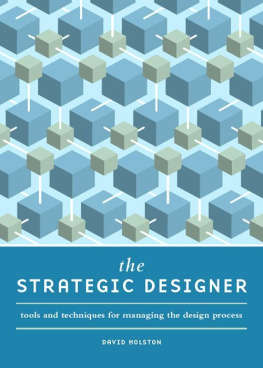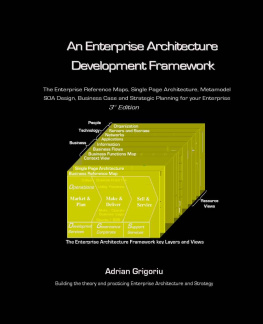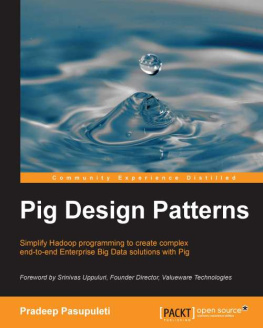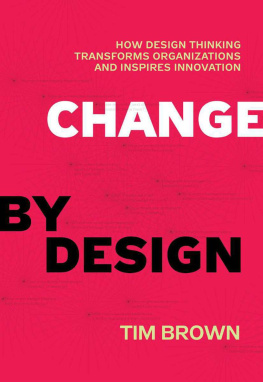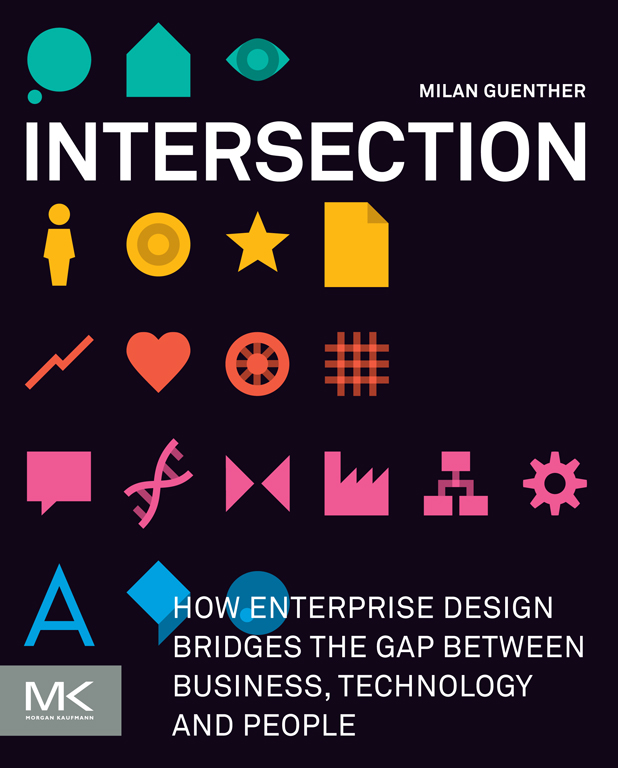Intersection is an aptly named book, both in its content and the evolving world of leading innovation that it describes. This book explains why new programs like ours are changing the form, content, and purposes for business education. Businesses need to challenge and rethink nearly everything about their processes, procedures, strategies, and cultures in order to successfully lead into the future.
Nathan shedroff, program chair, MBA in Design strategy, Oalifornia college of Art
Intersection is a landmark book on how to design enterprises in todays hyper-connected world. Founded on the relationships between identity, architecture and experiences, Milan Guenthers work explains both the change in mindset and practical approaches that are needed for success. If you are still designing your enterprise from the inside outwards, Intersection will convince you to think again. If you are already designing your enterprise outside-in, use this wonderful book to validate your work.
Chris Potts, author of FruITion and RecrEAtion
If you think that words like cross-channel, ecosystem, or bridge experience have no place in the world of large-scale corporate strategies, this is the book for you.
Intersection reframes enterprise-level design challenges through the lens of complexity, and provides us with a thorough interdisciplinary framework and a holistic approach to Enterprise Information Architecture that bridges business, technology and people into one seamless, dynamic design process. A must read.
Andrea Resmini & Luca Rosati, authors of Pervasive Information Architecture
This innovative book will give you a clear vision of organizations as interaction-driven businesses. Reading Intersection will enlighten you with deep insights into how to manage design in our contemporary world. First, you will understand that all large-scale design projects have an impact on organizational design and need to be managed as such: as Enterprise Design projects.
Second, this book conveyswhat most business people avoid to seethat any enterprise starts as an abstract intangible concept, but will only come to life through tangible signs, things, and places.
Third, you will understand better how designers think in systems, what is holistic thinking, and how design skills are useful for managing the interaction between all stakeholders by aligning identity, architecture, and experience of your enterprise.
Dr. Brigitte Borja de Mozota, Design Management institute Life Fellow / Universit Paris i / Ecole Parsons
Sustainable enterprises increasingly depend on a process incorporating inter-disciplinary knowledge on both strategic and operative levels. This book merges valuable insights from various perspectives into a holistic framework.
Marc Stickdorn & Jakob Schneider, Editors of This is Service Design Thinking
Copyright
Acquiring Editor: Andrea Dierna
Development Editor: Robyn Day
Project Manager: Mohanambal Natarajan
Editorial Design: Benjamin Falke, Sarah Matzke, Dennis Middeke, Eva Pika, Andrea Santema
Copyeditor: Philip Hellyer
Morgan Kaufmann is an imprint of Elsevier
225 Wyman Street, Waltham, MA 02451, USA
2013 Elsevier, Inc All rights reserved.
No part of this publication may be reproduced or transmitted in any form or by any means, electronic or mechanical, including photocopying, recording, or any information storage and retrieval system, without permission in writing from the publisher Details on how to seek permission, further information about the Publishers permissions policies and our arrangements with organizations such as the Copyright Clearance Center and the Copyright Licensing Agency, can be found at our website: www.elsevier.com/permissions.
This book and the individual contributions contained in it are protected under copyright by the Publisher (other than as may be noted herein).
Notices
Knowledge and best practice in this field are constantly changing. As new research and experience broaden our understanding, changes in research methods or professional practices, may become necessary. Practitioners and researchers must always rely on their own experience and knowledge in evaluating and using any information or methods described herein. In using such information or methods they should be mindful of their own safety and the safety of others, including parties for whom they have a professional responsibility.
To the fullest extent of the law, neither the Publisher nor the authors, contributors, or editors, assume any liability for any injury and/or damage to persons or property as a matter of products liability, negligence or otherwise, or from any use or operation of any methods, products, instructions, or ideas contained in the material herein.
Library of Congress Cataloging-in-Publication Data
Application Submitted
British Library Cataloguing-in-Publication Data
A catalogue record for this book is available from the British Library.
ISBN: 978-0-12-388435-0
For information on all MK publications visit our website at www.mkp.com
Printed in the China
13 14 15 16 1710 9 8 7 6 5 4 3 2 1

Introduction
Why Did We Call this Book Intersection?
When Jenifer Niles, then my editor at Morgan Kaufmann, proposed that name, I was intrigued.
This is a book about design, clearly. But it touches many adjacent or related areas, by approaching problems from different perspectives, aiming to bridge viewpoints and concerns, and connecting design to todays complex social ecosystems.
Therefore, the title expresses very well one of the key themes of this publication: looking beyond the immediate task, beyond your own comfort zone and background, beyond a briefing or project scope, and embracing viewpoints and practices other than your own.
Intersection gives you a thinking model, a methodological framework, and a vocabulary to do just that. It is a resource to apply design thinking and practice to challenges you consider relevant and important to tackle. It promotes both a mindset and an approach that enables you to take a step back, and look at the big picture of everything that matters when approaching a difficult design challenge. The face of companies, organizations, public services, and other types of enterprise is changing. Formerly clear lines are fading awaybetween online and offline, internal and external, owned and shared, customer and user, social and business, branding and operations. When thinking holistically about a complex challenge, such distinctions just dont seem to make much sense anymore.
One of the immediate consequences of these shifts is the need to align, bridge and connect; more and more professionals are calling themselves architects, designers, or consultants. If you are among those, you inevitably face the challenge of transforming ecosystems, regardless of your particular background, focus area, or level in an organization. Such systemic challenges go well beyond the problems of designing products, web sites, or services in isolation.





